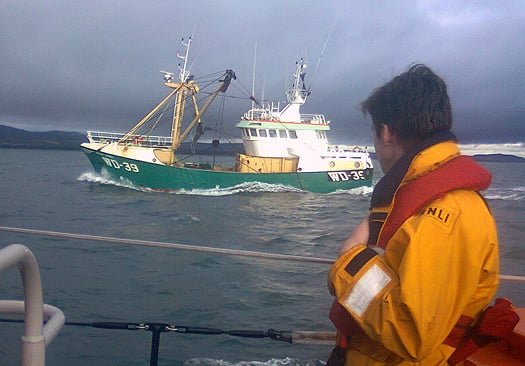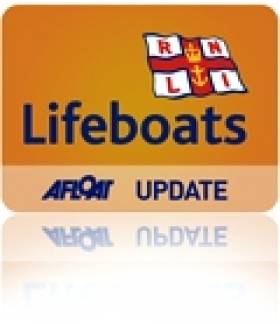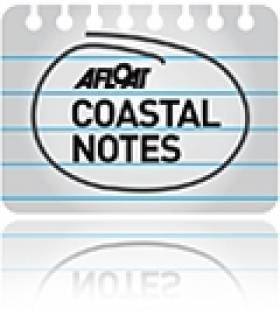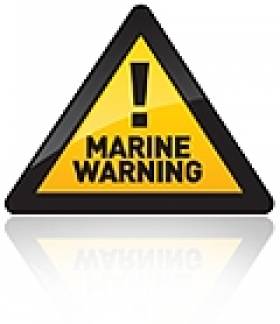Displaying items by tag: oil
Wicklow Lifeboat Assists Fishing Vessel after Collision with Tanker
The alarm was raised after the collision took place about 20 miles off the Welsh Coast in the early hours of Monday morning. A volunteer crew from Holyhead RNLI lifeboat Station put to sea along with Wicklow lifeboat.The 3 crew of the beam trawler were uninjured in the incident, but the vessel sustained some damage to fishing gear, but no damage below the waterline. The tanker was able to resume her passage and no damage or pollution was reported.

Wicklow RNLI lifeboat escorting the fishing vessel. Photo: RNLI/ Wicklow
The trawler was able to motor back towards the Irish Coast under escort by Holyhead lifeboat. At 07.33hrs Wicklow lifeboat arrived on scene. Holyhead lifeboat was then stood down and returned to station.
Wicklow lifeboat escorted the Beam trawler on the journey back to Wicklow harbour and was safely secured alongside the East pier by 10.30am.
The 3 crew were said to be shaken but uninjured after their ordeal.
Bon Voyage to Stena Voyager
The Stena Voyager high-speed ferry will make its final crossing between Belfast and Stranraer in mid-November.
BBC News cites the high cost of running the service, as well as its limited freight capacity, as reasons for the mothballing of the Stena HSS (High Speed Service).
The world's biggest high-speed ferry was a revelation when it was launched in 1996. The catamaran could reach speeds of up to 40 knots powered by enormous gas turbine engines.
But the rising cost of oil prompted a reduction in the ferry's cruising speed to save costs, making room for competition from conventional ferry routes with larger freight capacities.
The Voyager's fate was sealed when Stena Line announced plans to move its Stranraer port to a new location that will shave 20 minutes off the crossing for the two new but standard ferries that will replace it.
As previously reported on Afloat.ie, the Stena HSS between Dun Laoghaire and Holyhead will also be suspended from later this month, though it is planned to resume service in 2012 for the summer season.
Irish Oil Firm Wins Lucrative Australian Gas Field Contract
A US$2 billion-plus contract to work in the Gorgon gas fields project in Western Australia has gone to Irish oil company Kentz, the Irish Echo reports.
The work involves support in various aspects of the construction of three processing plants for liquefied natural gas from the Greater Gorgon fields - some 130km from the northwest coast of Western Australia - with a total annual capacity of 15 million tonnes.
According to Kentz, the contract will create more than 1,650 jobs for construction personnel in Western Australia.
The Irish Echo has more on the story HERE.
Dublin Bay Oil, Gas, Coal...and Waste-Water!
The work is part of a Dublin City Council project to evaluate an extension at the Ringsend plant where treated water will be released into the bay. The council are conducting detailed feasibility studies which will be examined for an Environmental Impact Assessment.
To date the project has involved two other rigs, the Aran 250 and the larger Excalibur which remains in the bay. The barges will be towed to 20 pre-determined bore-hole locations in the bay where the jack-up rig barges operate 'legs' to sit on the seabed which enables a steady working platform. The rigs are operating on a continuous basis in an area covering most of Dublin Bay and close to the Burford Bank on the eastern fringes.
In addition a buoy will be positioned 300-metres of the barge during drill operations, which is expected to take approximately one week for each drill. For information on the location of the bore-holes, they can viewed from the Dublin Port website by clicking HERE The project is expected to be completed in late Spring.
Several support craft are engaged in the project that recently included the Seabed Worker, a 3,923 gross tonnes Norwegian anchor-handling tug supply vessel (AHTS) the tugs Multratug 7, MTS Valiant and Trojan and the RIB-craft sisters, Brian Boru and James Joyce which are on standby duties. Like the Trojan, the 12-seater RIBS are based at the Poolbeg Yacht Club Marina where in the tourist season the craft provide excursions in Dublin Bay for Sea Safari Tours. In October the project also required the services of the yellow-hulled catamaran, Xplorer to carry out a bathymetric survey of Dublin Bay. The larger tugs and rigs are based opposite in Alexandra Basin / Ocean Pier.
The largest drill-rig working to date on the project, the Excalibur arrived under the tow of the Multratug 7 on a misty morning on Christmas Day. Due to the weather conditions the red-hulled craft slipped quietly into the port. Several days later the imposing looking craft re-emerged with its six-towering jack-up 'sea-legs' that jutted skywards into an otherwise horizontal expanse of Dublin Bay.
The sight of the rig has presented many onlookers to mistakenly believe the drilling was for oil!...Not so but the assumption is not surprising given the reports last year of an oil-field discovery named the Dalkey Island Prospect. The name for the oil-field was referred to Dalkey, as the coastal suburb on the southern shores is the nearest landfall to the exploratory well sites at the Kish Bank Basin.
In fact this kind of exploratory activity was again to confuse residents throughout the bay when the drill-ship, Fugro Synergy was offshore at the Kish Bank between December 2009 and early Spring of 2010. Though on this occasion the search was not for oil but coal!
During this period the 5,200 tonnes vessel equipped with a drill-tower, seemed to be a near permanent feature on the horizon. A series of drill-wells up to 3,500-metres were conducted when the 2009 built ship was contracted to Irish based VP Power Ltd, to determine the commercial viability of extracting coal from the sea for generating electricity. The Underground Coal Gasification (UCG) project is a process where coal is heated in underwater rock reservoirs to extract gas, essentially converting gas-from-coal energy. Otherwise this method is commonly referred to as a 'clean' technology.
In addition to last year's search for deposits of large coal seams under the seabed, there was reports of a significant natural resource in the form of oil!... when several exploratory blocks again in the Kish Bank Basin were surveyed. The company behind this venture, Provident Resources, another Irish based exploration company, conducted initial oil surveys using air-born craft and as such no actual drill-based ships or rigs were used. Though should any oil flow, such an operation would be required.
Incidentally the Excalibur is designed also to perform offshore wind turbine installation work and is equipped with a 250-ton crane to hoist the wind-farm components. The vessel is operated by Fugro Seacore, a subsidiary of the Dutch parent company, Fugro, which also managed the drill-ship Fugro Synergy.
Government to Showcase New Exploration Opportunities in Irish Waters
Minister for Natural Resources, Conor Lenihan will next week front a major promotion of Ireland's oil and gas exploration potential to a large global audience. Minister Lenihan will showcase new exploration opportunities in Irish waters – the 2011 Atlantic Margin Licensing Round – at a major international petroleum conference in Singapore.
Ireland's offshore exploration potential will take centre stage at the Oil and Gas Investment Asia conference where Minister Lenihan will deliver a keynote speech, in which he will declare Ireland's offshore open for business.
Speaking prior to this departure for Singapore, Minister Lenihan remarked
"this conference and associated meetings and briefings represent an excellent opportunity to promote Ireland's offshore as a world class exploration destination.
Although we already have two large Asian exploration companies active in Ireland's offshore, we can not expect Asian companies to be fully aware of Ireland's potential.
I will deliver a strong message that as well as our offshore having lots of exploration potential, Ireland is a politically stable economy, with a competitive tax regime, in which their business will be welcome and encouraged to flourish."
Across the three day event Minister Lenihan and his officials will brief senior executives from the largest Asian oil companies about prospects in the Irish offshore. These include Petronas and STX as well as the National Oil corporations of Singapore, the Philippines and Korea. The Minister's itinerary will also include Enterprise Ireland meetings connected with Minister Lenihan's brief as Minister for Science, Technology and Innovation.
Minister Lenihan will particularly stress the opportunities presented by Ireland's latest offshore licensing round – the 2011 Atlantic Margin Licensing Round.
"This round will be Ireland's largest licensing round to date, covering an area of just over a quarter of a million square kilometres" he said.
"It's exciting because we know that within this Atlantic Margin area there are a number of large sedimentary basins with proven petroleum prospectivity. The fact that there are currently 27 companies involved in the offshore petroleum industry in Ireland, including many international companies and some of the world's majors is positive, but Ireland needs to attract a higher level of exploration investment if the petroleum potential of our offshore territory is to be realised. The objective of the 2011 Licensing Round is to attract a greater share of mobile international exploration investment to Ireland.
Now is the time to deliver this message on the world stage – we will do so next week in Singapore," he concluded.
Tony O'Reilly to drill Dublin Bay for oil?
“We are delighted to confirm that our ongoing analysis of the Kish Bank Basin has revealed the presence of a large untested structure that warrants further investigation," said O'Reilly.
"The Dalkey Island exploration prospect presents the potential for a large oil accumulation in shallow water off the east coast of Ireland. The partners have agreed on a focused work programme aimed at further de-risking this prospect, prior to any drilling programme."
The company, a partner of Malaysian Petrol outfit Petronas, has also identified the bank as a prospect for carbon sequestration storage, with a capacity of up to 270 million tonnes of gas.
A link to the full release is here. (pdf download)


































































